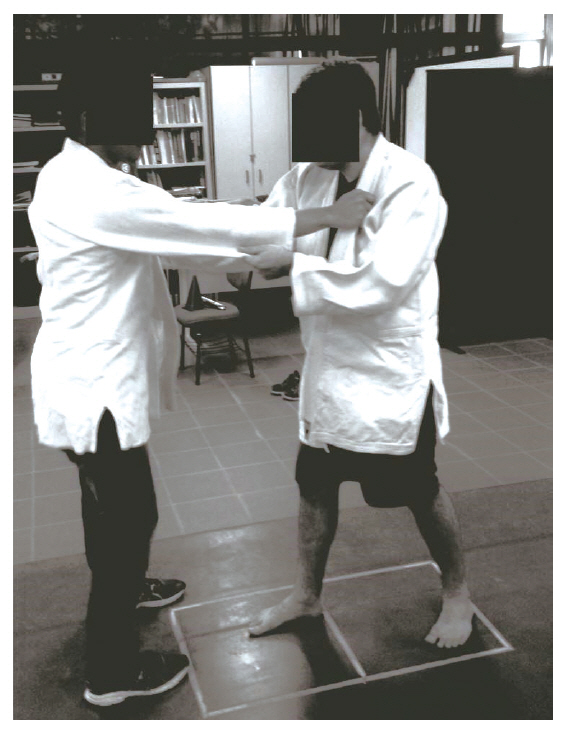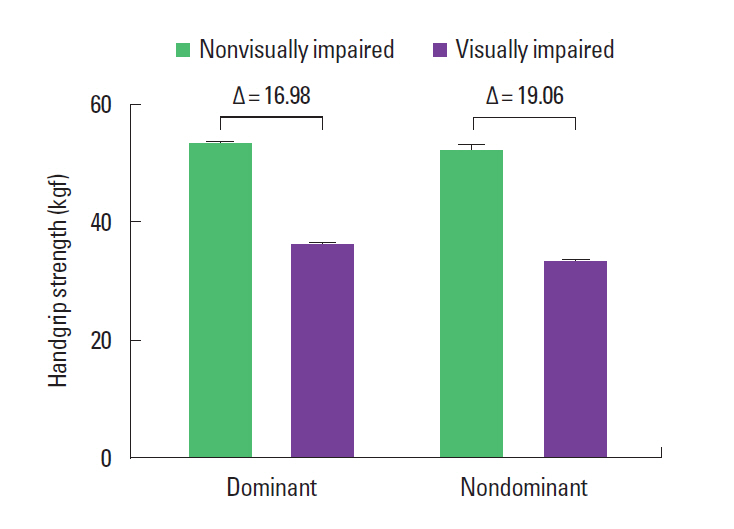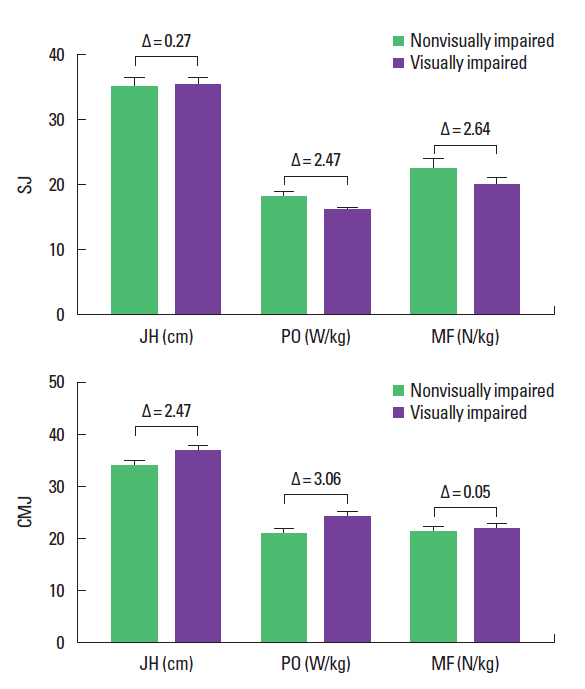INTRODUCTION
Judo is an Olympic and Paralympic combat sport divided by sex and weight categories. The Paralympic judo is composed by visually impaired athletes who follow the same rules as Olympic judo with one main exception: the match is initiated with the athletes positioning their grips on the opponent’s judogi, and this procedure is repeated every time combat is interrupted (Gutiérrez-Santiago et al., 2011). Judo matches are a constantly unstable environment, in which the athletes seek advantages by mainly disrupting the balance of their opponent to attack or contra-attack. According to Yoshitomi et al. (2006), judo athletes try to unbalance their opponent while maintaining their own stability to perform the throwing techniques. Thus, the balance is essential to efficiently throw the opponent with the back on the ground to obtain the high scores.
The center of pressure (COP) is an accurate measurement to estimate the postural stability (balance) in standing position, and represents the point where the resultant force acts on the support surface (Ruhe et al., 2010). Few studies have investigated the COP in judo athletes, as Santos et al. (2018) who verified increase in COP displacement and velocity over a simulated judo match, and Yoshitomi et al. (2006), who found better postural control system (lower COP displacement and velocity) in judo athletes compared to nonathletes after an unexpected external perturbation.
The standing balance may be affected by individual strength level. Dias et al. (2011) reported that 80% of COP variability can be associated to handgrip strength level in judo athletes, indicating that it generates changes in the postural stability. However, this study was performed with judo athletes who are not visually impaired. In general, the muscle strength and power in upper and lower limbs have been considered determining factors to judo performance (Detanico et al., 2012; Franchini et al., 2011; Franchini et al., 2013). For example, the isometric handgrip strength is widely required during judo matches to maintain the grip in the judogi and control the distance between the opponent (Bonitch-Góngora et al., 2012; Franchini et al., 2011; Kons et al., 2018). The muscle power of the lower limbs is relevant to perform several throwing techniques (Detanico et al., 2012; Torres-Luque et al., 2015) being correlated with the performance in judo-specific tests (Detanico et al., 2012).
In visually impaired judo athletes, it is possible to suggest that the matches present longer isometric handgrip strength actions than conventional judo matches, due to the higher grip time on the judogi (Gutiérrez-Santiago et al., 2011); however, no studies have analyzed the handgrip strength performance in both visually and non-visually impaired judo athletes. On the other hand, Loturco et al. (2017a) have verified higher values of muscle power in the lower limbs (i.e., vertical jump performance) in Olympic judo athletes compared to Paralympic ones, but no difference in maximal isometric strength exercises was found between them. According to the authors, the visual impairment may affect the performance in specific muscle power exercises due to the differences in visual-proprioceptive integration, which possibly leads to disparities between skill strategies during the exercises, but it is not yet clear.
Neuromuscular and postural control (standing balance) in judo athletes who are visually or nonvisually impaired has not been investigated yet. It is known that there is extreme difficulty in obtaining a large sample size particularly of visually impaired judo athletes, due to smaller number of visually impaired judo athletes. An alternative is to propose case studies, which has already been used in Paralympic judo (Loturco et al., 2017b) and other Paralympic sports (Antunes et al., 2017; Salvador et al., 2016). Thus, the aim of this study was to analyze the neuromuscular and postural control in visually and nonvisually impaired judo athletes.
MATERIALS AND METHODS
Participants
Two judo athletes, with one being visually impaired (congenital blindness) and the other not, participated in the study. The demographic, anthropometric, and judo-technical characteristics of the athletes are described in Table 1. The athletes evaluated were training regularly (physical, technical, and tactical training) for 4–5 times a week, and competing at the national level during the test period. Participants did not report musculoskeletal disorders or injuries that would influence their maximal performance, besides having trained judo systematically for the last 5 years and not being in a rapid weight loss period. Both participants were older than 18 years, and received a detailed verbal explanation of the purpose, methods, and potential risks/benefits of the study. Afterward, athletes signed a written informed consent form agreeing to participate in the investigation. The current study was approved by the Research Ethics Committee of the local university (CAAE: 630-53516.4.0000.0121), in accordance with the Declaration of Helsinki.
Handgrip strength protocol
We adopted the procedures of American Society of Hand Therapy to testing the maximal isometric handgrip strength. Participants were seated and the shoulders were positioned in adduction and neutral rotations, and the elbow flexed at 90° with the forearm in half-pronation and with a neutral grip. Athletes were instructed to perform maximum effort in a handgrip dynamometer (Carci, SH 5001 model) during 3 sec in the dominant hand with 30-sec rest period between each trial (three trials were performed). We used the highest value of handgrip strength as performance variable. The reliability of the handgrip assessment was tested and presented an intraclass correlation coefficient (ICC) of 0.92 for the dominant hand.
Vertical jump assessment
The muscle power of the lower limbs was accessed through two vertical jump protocols: countermovement jump (CMJ) and squat jump (SJ). Both tests are reliable and valid as they are widely used to estimate the muscle power of the lower extremities (Markovic et al., 2004). Before the CMJ and SJ assessment, participants performed exercises during a familiarization/warm-up period which include 30 sec of hopping on a trampoline, three series of 10 hops on the ground, and five submaximal CMJs. After a 3-min resting period, athletes performed three CMJ on a piezoelectric force platform (model 9290AD, Kistler, Quattro Jump, Winterthur, Switzerland), which measures vertical ground reaction force sampling at 500 Hz. Athletes started the CMJ protocol from a static standing position. They were instructed to perform a countermovement (descent phase), followed by a rapid and vigorous extension of the lower limb joints (ascent phase) and jump as high as possible. They also were recommended to flex their knees at 90° during the eccentric-concentric phases. We provide a verbal feedback to the participants to encourage them to maintain a knee angle of approximately 90° and maximum performance during the jump. Ten minutes afterward the CMJ protocol, the SJ was performed, that consisted of the athlete to jump from a static position, with the knees flexed at about 90° and the hands on the waist. The SJ was performed without any countermovement and using only the concentric phase of the jump. We used the mean value of jump height, power output, and maximal force obtained in the concentric phase of the jump (within three trials). The reliability was tested among the three trials of the vertical jumps (CMJ and SJ) and presented an ICC ranging from 0.97–0.99 for jump height, power output and maximal force.
Center of pressure
The participants were assessed in three positions: neutral position, anteroposterior position (right foot forward according to the dominant side), and judo combat base (Migi-shizentai – right foot forward according to the dominant side with the grip on the judogi) (Fig. 1) using a force platform (OR6-6, AMTI, Watertown, MA, USA). The platform was placed on a stable surface on the floor to avoid signal distortion and noise. A reference point was placed 2 m in front of the athlete at eye level (for nonvisually impaired athlete). Both participants were informed about the importance of maintaining the positions fixed and were asked to avoid any body movement. Three consecutive 60-sec repetitions were performed (Carpenter et al., 2001) at three different protocols in a random order. Displacement signals were smoothly digitally by a recursive Butterworth low pass filter with a 10-Hz cutoff frequency to assure that 99% of power spectral density was below this threshold (Clark et al., 2010). Raw data were recorded at a frequency of 40 Hz. We removed the first 10 sec of each trial of the analysis to avoid any interference from delayed stabilization of recording equipment after the person stepped onto the force platform (Raymakers et al., 2005).
According to Ruhe et al. (2010) and Santos et al. (2018) recommendations, three types of COP parameters were assessed: positioning, velocity, and dispersion. COP positioning was determined by computing the composite COP displacement length, area, and velocity. Additionally, COP positioning in the anteroposterior (X-axis) and mediolateral axis (Y-axis), mean position (XMEAN and YMEAN), velocity (XVEL and YVEL), and resultant (YRES) for length and velocity, were also computed and reported. Data were collected at a sampling frequency of 2,000 Hz and were smoothed using a fifth-order, zero phase, low pass Butterworth digital recursive filter with a frequency range set of 10 Hz. Area of COP was estimated by fitting an ellipse that encompasses 95% of COP data. Off-line data analyses were developed with custom-written scripts (R 2014a, MathWorks, Natick, MA, USA).
Statistical analysis
Data are reported as mean±standard deviation. The differences between the means (Δ) and effect size (ES) were calculated in order to analyze the biomechanical variables between the athletes. The GPower3.1 software (University of Kiel, Kiel, Germany) was used to calculate ES, and the criterion proposed by Hopkins (2002) was used to classify ES: 0.0–0.2, trivial; 0.21–0.6, small; 0.61–1.2, moderate; 1.21–2.0, large; and 2.1–4.0, very large.
RESULTS
In the neutral and anteroposterior position, all results indicated lesser COP parameters (length, velocity, and area [very large effect]) for the visually impaired athlete. The disparity between the athletes seems to be reduced when assuming the judo position Migi-shizentai, mainly for XMEAN, XVEL, and area, showing similar balance in these variables. Despite this, the visually impaired athlete presented higher balance for length (YMEAN; X, YRES) and velocity (YVEL; X, YRES) (Table 2).
Fig. 2 shows the COP behavior in the neutral position, anteroposterior, and Migi-shizentai in visually and nonvisually impaired athletes, ratifying the findings that the visually impaired athlete showed lesser displacement and consequently better standing balance than non-impaired athlete in the first two positions, reducing the difference in the judo-specific position.
Fig. 3 presents the maximal handgrip strength in visually and nonvisually impaired athletes at dominant and nondominant hand. The results indicate higher values for the nonvisually impaired athlete in both dominant (ES=24.01, very large) and nondominant hand (ES=27.03, very large).
The analysis of CMJ indicated very large effect for jump height (ES=2.18) and power output (ES=2.91) in favor of the visually impaired athlete (Fig. 4). On the other hand, in the SJ, the ES analysis showed very large effect for power output (ES=5.14) and maximal force (ES=2.02) in favor of the nonvisually impaired (Fig. 4).
DISCUSSION
The purpose of the present study was to analyze the neuromuscular and postural control in visually and nonvisually impaired judo athletes. Both athletes show similar demographic, anthropometric, and judo-technical characteristics. In our study, we found that the visually impaired athlete showed higher balance (lesser length, velocity, and area) in the neutral and anteroposterior positions than the nonvisually impaired athlete. In the Migi-shizentai position, the disparity between both athletes was reduced, particularly in the area of displacement. Furthermore, the visually impaired athlete has shown higher performance in the SJ (power output and maximal force) but lesser performance in the CMJ (jump height and power output) and handgrip strength test compared to the nonimpaired athlete.
The postural control during judo matches is an important aspect in the execution of throwing techniques (Santos et al., 2018; Yoshitomi et al., 2006) or during the defense in both judo modalities (conventional and with visual impairment). However, in visually impaired athletes, the postural control has a greater peculiarity due to the low or no vision of the athletes (Krabben et al., 2018). In this case, other postural control systems (vestibular and somatosensory) seem to assume a more prominent role in maintaining balance, and thus compensate for the weak or absent visual input (Schwesig et al., 2011). This fact may explain the higher balance in the neutral and anteroposterior position in the visually impaired. Moreover, the lesser variation of the COP area between the two athletes in the judo-specific position (Migui-shinzetai) may show an adaptation to the actions involving judo, e.g., during the kuzushi (imbalance) that is essential in the execution of judo throwing techniques.
The vertical jump performance (CMJ and SJ) is the best parameter to assess the muscle power of the lower limbs (Markovic et al., 2004) and has been used frequently in judokas non-visually impaired (Franchini et al., 2011) and visually impaired (Loturco et al., 2017a; Loturco et al., 2017b). In our study, the visually impaired athlete has shown higher effect for power output and maximal force in the SJ compared to the non-visually impaired, while in the CMJ, the opposite was found (jump height and power output were higher in the visually impaired). Loturco et al. (2017a) evaluated judo athletes from Brazilian Olympic and Paralympic teams and verified higher values in jump height and maximum propulsive power in the SJ, bench press, and standing barbell row in the Olympic team than Paralympic; but the maximal isometric strength in the half-squat and bench press did not differ between the groups. It is possible to suggest that the visual impairment may affect the performance in specific muscle power exercises, as there is no field of view, the perception of safety and balance decreases (Makris et al., 1993). Thus, the motion pattern during the jump execution seems safer in the SJ than CMJ, which could explain the higher maximal force and power output produced during the propulsive phase of the SJ by the visually impaired. In addition, the differences in the visual-proprioceptive aspects between the athletes possibly lead to disparities between their performance strategies, mainly because the visual stimulus assists in tasks involving higher velocity (e.g., tasks involving the shortening-stretch cycle, as the CMJ).
Maximal isometric handgrip strength is one of the determining factors of judo performance (Calmet et al., 2010; Franchini et al., 2011), especially during grip disputes and moments that precede the throwing techniques (Kons et al., 2018). The findings of this study demonstrate a very large effect for both hands in the nonvisually impaired athlete compared to the visually impaired. It is worth noting that the handgrip strength test is a generic assessment and does not approach specific actions of the sport, although it is widely used to evaluate judo athletes, as it measures the forearm strength that represents the moments of grip on the judogi (Bonitch-Góngora et al., 2012; Franchini et al., 2011; Kons et al., 2018). The visually impaired athlete starts the match by positioning his/her grip on the opponent’s judogi, and this procedure is repeated every time combat is interrupted (Gutiérrez-Santiago et al., 2011). Thus, a speculative explanation is that the nonvisually impaired athletes have other possibilities to perform the grip during matches, i.e., in different parts of the judogi jacket, thus allowing higher adaptations to the forearm and finger flexor muscles than the visually impaired athletes.
Finally, the case study was composed only by two athletes, which limited our statistical analyses. However, this is the first study that analyzed neuromuscular and postural control parameters in visually and nonvisually impaired athletes with similar demographic, anthropometric, and technical characteristics. Thus, we recommend to the coaches and sports scientists to monitor the balance, mainly in judo-specific postures, as well as to use muscle power of lower limbs assessments that increase the perception of safety in visually impaired athletes, e.g. SJ instead of CMJ.
We conclude that the visually impaired athlete presented higher postural stability (balance), mainly in the neutral and anteroposterior positions, than the nonvisually impaired athlete. In the Migi-shinzentai position, the postural stability was higher in the COP length and velocity in the visually impaired judoka, but not in the area, showing a possible influence of judo practice in the standing balance in the judo-specific position. Considering the neuromuscular aspects, the visually impaired athlete presented higher performance in the SJ but lesser performance in the CMJ and isometric handgrip strength test than the nonvisually impaired.













